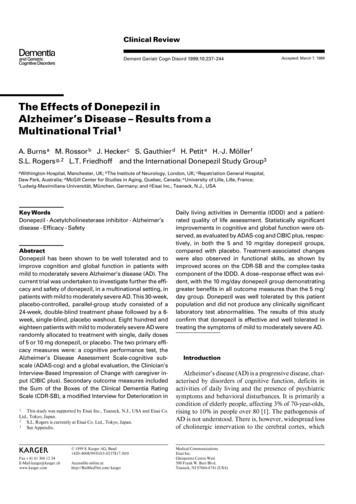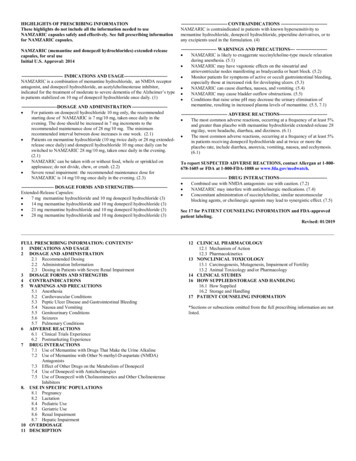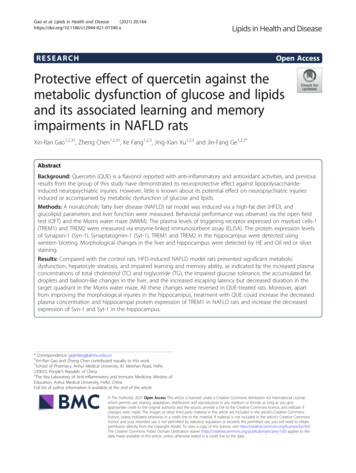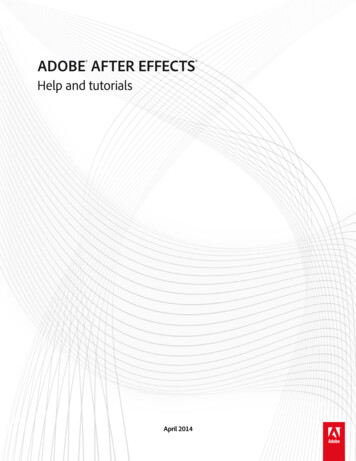
Transcription
Clinical ReviewDement Geriatr Cogn Disord 1999;10:237–244Accepted: March 7, 1999The Effects of Donepezil inAlzheimer’s Disease – Results from aMultinational Trial1A. Burns a M. Rossor b J. Hecker c S. Gauthier d H. Petit e H.-J. Möller fS.L. Rogers g, 2 L.T. Friedhoff and the International Donepezil Study Group3a Withington Hospital, Manchester, UK; b The Institute of Neurology, London, UK; c Repatriation General Hospital,Daw Park, Australia; d McGill Center for Studies in Aging, Quebec, Canada; e University of Lille, Lille, France;f Ludwig-Maximilians-Universität, München, Germany; and g Eisai Inc., Teaneck, N.J., USAKey WordsDonepezil W Acetylcholinesterase inhibitor W Alzheimer’sdisease W Efficacy W SafetyAbstractDonepezil has been shown to be well tolerated and toimprove cognition and global function in patients withmild to moderately severe Alzheimer’s disease (AD). Thecurrent trial was undertaken to investigate further the efficacy and safety of donepezil, in a multinational setting, inpatients with mild to moderately severe AD. This 30-week,placebo-controlled, parallel-group study consisted of a24-week, double-blind treatment phase followed by a 6week, single-blind, placebo washout. Eight hundred andeighteen patients with mild to moderately severe AD wererandomly allocated to treatment with single, daily dosesof 5 or 10 mg donepezil, or placebo. The two primary efficacy measures were: a cognitive performance test, theAlzheimer’s Disease Assessment Scale-cognitive subscale (ADAS-cog) and a global evaluation, the Clinician’sInterview-Based Impression of Change with caregiver input (CIBIC plus). Secondary outcome measures includedthe Sum of the Boxes of the Clinical Dementia RatingScale (CDR-SB), a modified Interview for Deterioration in1This study was supported by Eisai Inc., Teaneck, N.J., USA and Eisai Co.Ltd., Tokyo, Japan.2S.L. Rogers is currently at Eisai Co. Ltd., Tokyo, Japan.3See Appendix.ABC 1999 S. Karger AG, Basel1420–8008/99/0103–0237 17.50/0Fax 41 61 306 12 34E-Mail karger@karger.chwww.karger.comAccessible online at:http://BioMedNet.com/kargerDaily living activities in Dementia (IDDD) and a patientrated quality of life assessment. Statistically significantimprovements in cognitive and global function were observed, as evaluated by ADAS-cog and CIBIC plus, respectively, in both the 5 and 10 mg/day donepezil groups,compared with placebo. Treatment-associated changeswere also observed in functional skills, as shown byimproved scores on the CDR-SB and the complex-taskscomponent of the IDDD. A dose–response effect was evident, with the 10 mg/day donepezil group demonstratinggreater benefits in all outcome measures than the 5 mg/day group. Donepezil was well tolerated by this patientpopulation and did not produce any clinically significantlaboratory test abnormalities. The results of this studyconfirm that donepezil is effective and well tolerated intreating the symptoms of mild to moderately severe AD.IntroductionAlzheimer’s disease (AD) is a progressive disease, characterised by disorders of cognitive function, deficits inactivities of daily living and the presence of psychiatricsymptoms and behavioral disturbances. It is primarily acondition of elderly people, affecting 3% of 70-year-olds,rising to 10% in people over 80 [1]. The pathogenesis ofAD is not understood. There is, however, widespread lossof cholinergic innervation to the cerebral cortex, whichMedical CommunicationsEisai Inc.Glenpointe Centre West500 Frank W. Burr Blvd.Teaneck, NJ 07666-6741 (USA)
forms the basis for memory impairment, a hallmark of thedisease [2]. Theoretically, increasing the levels of brainacetylcholine may improve clinical symptoms in AD.Most successful therapeutic strategies have focused onblocking the breakdown of acetylcholine by inhibiting itsenzymatic hydrolysis.Donepezil hydrochloride (Aricept )4 is a potent and specific inhibitor of acetylcholinesterase with minimal effectson butyrylcholinesterase [3] and, as a piperidine-based molecule, is chemically distinct from other cholinesterase inhibitors. It has a long duration of action, with a half-life ofapproximately 70 h [4–6], which allows once-daily administration. Preclinical [7] and clinical studies in Japan [8]and the USA [9] have shown that donepezil is devoid ofunexpected toxicity, particularly the hepatotoxicity characteristic of acridine-based cholinesterase inhibitors.Phase II and Phase III [10, 11] double-blind, placebocontrolled clinical trials conducted in the USA haveshown that donepezil significantly improves cognitiveand global function, with these benefits being maintainedduring open-label, long-term donepezil administration[12]. Donepezil was studied in a population where 95% ofpatients had prior medical or co-morbid conditions, andwas shown to be well tolerated, producing no clinicallysignificant changes in metabolic, cardiovascular, hepaticor renal function. In addition, no clinically significantdrug-drug interactions were observed, even though over80% of the patients in these trials were taking one or moreconcomitant medications. Importantly, the cytochromeP450 isoenzyme inhibitors cimetidine [13] and ketoconazole [14] produce no clinically significant changes in thepharmacokinetics of donepezil, suggesting that dose modification is not necessary when donepezil is co-administered with such compounds.The objectives of the current study were to evaluatefurther the safety and efficacy of once-daily administration of donepezil at doses of 5 and 10 mg, versus placebo,in a large, multinational cohort of patients with mild tomoderately severe AD.Materials and MethodsPatient PopulationMen and women, 650 years of age, with probable AD wererecruited at 82 sites in Australia, Belgium, Canada, France, Germany,Ireland, New Zealand, South Africa and the UK. For the diagnosis ofAD, patients satisfied both the criteria defined by the DSM-III-R forprimary degenerative dementia of the Alzheimer type [15] and by theguidelines of the National Institute of Neurological and Communica4Aricept is a registered trademark of Eisai Co. Ltd., Tokyo, Japan.238Dement Geriatr Cogn Disord 1999;10:237–244tive Disorders and Stroke and Alzheimer’s Disease and Related Disorders Association (NINCDS-ADRDA) for probable AD [16].Patients were required to have mild to moderately severe AD, atscreening and baseline, as defined by Mini-Mental State Examination [17] scores between 10 and 26 inclusive, and Clinical DementiaRating (CDR) [18] scores of 1 (mild) or 2 (moderate). All patients hada computerised tomography or magnetic resonance imaging scanwithin the previous 6 months, and patients with structural lesions orsignificant vascular changes were excluded. Women were required tobe 2 years post-menopausal or surgically sterile. In addition, patientshad to be generally healthy, with vision and hearing sufficient forcompliance with the testing procedures. Patients with other neurological or psychiatric disorders, asthma, significant uncontrolled gastrointestinal, renal, hepatic, endocrine or oncological disorders, orwho were taking prohibited study medications, were excluded.The study was conducted in accordance with the principles statedin the revised Declaration of Helsinki (1989) and the European Community GCP Guidelines (1990). All centres had local ethics committee approval. Prior to screening, the nature and purpose of the investigation was explained to the patient and caregiver, and written,informed consent was obtained from both.Study DesignThis was a 30-week, randomised, multinational, multicentre, placebo-controlled, parallel-group study with a 24-week, double-blindtreatment phase followed by a 6-week, single-blind, placebo washout.Patients were screened within 2 weeks of entry and randomlyassigned to receive 5 or 10 mg/day donepezil, or placebo. Study medication was administered orally, once-daily, in the evening. A blindedschedule was used for the 10 mg/day donepezil group, where patientsinitially received 5 mg/day for the first 7 days, then 10 mg/day for theremainder of the study. Efficacy and safety evaluations were conducted at baseline and at Weeks 6, 12, 18, 24 and 30.Outcome MeasuresThe Alzheimer’s Disease Assessment Scale-cognitive subscale(ADAS-cog) [19], and a Clinician’s Interview-Based Impression ofChange with caregiver input (CIBIC plus) [20], were the two primaryoutcome measures used, reflecting cognition and global function,respectively.The secondary efficacy variables used were the Sum of the Boxesof the Clinical Dementia Rating scale (CDR-SB) which sums the ratings from six domains (‘boxes’) of the CDR to provide a consensusbased, global clinical measure [21], a modified Interview for Deterioration in Daily living activities in Dementia (IDDD) [22] and apatient-rated quality of life (QoL) assessment [23]. Descriptions ofADAS-cog, CIBIC plus, CDR-SB and QoL assessment tools havebeen reported previously [10, 11].The IDDD was designed originally as a severity instrument forquantifying impairment in activities of daily living of dementiapatients. It consists of 33 items and the severity of impairment israted on a 7-point scale, where 1–2 no or slight impairment, 3–4 mild impairment, 5–6 moderate impairment and 7 severeimpairment, giving a total score range of 33–231 points. The IDDDprovides a self care tasks rating (16 items) and complex tasks rating(17 items). Both initiation of tasks and their performance by thepatient are quantified during a structured interview of the caregiver.At baseline, severity of disability was scored for each item of theIDDD. To assess change at subsequent visits, the severity scale wasmodified to measure change from baseline, where the evaluator gers/Friedhoff
improvement, no change or deterioration in comparison to the baseline performance level. In assessment of change, a 7-point Likert-typescale was used, where 1 marked improvement from baseline, 4 nochange from baseline and 7 marked deterioration from baseline.Hence, a patient exhibiting no change in complex task functioning,for example, would receive a total score of 68 (17 ! 4) on the IDDDcomplex tasks. Thus, it follows that a score below 68 would representimprovement and a score above 68 would denote deterioration. Thistrial represents the first use of this modification of the IDDD scale.Unlike the ADAS-cog and CIBIC plus assessment tools, which arewidely accepted in research settings, there are no instruments to measure change in the patients’ ability to perform both complex and basic daily tasks that are in common use in clinical trials for AD.Safety MeasuresAdverse events were monitored at each visit by questioning boththe patient and the caregiver, as well as through direct observation.All adverse events, whether reported or observed, were recorded,together with the time and date of onset and cessation, severity ofcondition and whether, in the opinion of the investigator, the eventwas related to donepezil treatment. Serious adverse events (SAE)included fatal or life-threatening situations, permanently disablingconditions or incidents that required or prolonged hospitalisation.Blood pressure and pulse were measured at all clinic visits, withtemperature and respiration also measured at baseline and Week 30.A standard 12-lead ECG was performed at the start and end of thedouble-blind treatment. In addition, clinical laboratory assessmentsincluding haematology, clinical chemistry and urinalysis were conducted at each clinic visit.Table 1. Patient demographicsPlaceboPatientsAge, yearsMean B SERange27471B0.550U90Donepezil5 mg/day10 123 (45)151 (55)107 (39)164 (61)118 (43)155 (57)RaceCaucasianOther272 (99)2 (1)270 (100)1 (! 1)271 (99)2 (1)Weight, kgMean B g MMSEMean B SERange20B0.310U2620B0.310U2620B0.29U26Screening CDR0.51.02.00230 (84)44 (16)2 (1)222 (82)47 (17)2 (1)236 (86)35 (13)Figures in parentheses are percentages. MMSE Mini-Mental State Examination.Statistical AssessmentsAn original sample size of 150 patients/treatment group was estimated, based on the results obtained from an earlier Phase II study ofdonepezil and from published results from US tacrine trials. Thesample size had 80% power to detect a difference of 0.27 points inmean CIBIC plus scores for each donepezil treatment group whencompared to placebo, at a 0.05 significance level. The patient completion rate was estimated to be 80%. During the study, a blindedexamination of the ADAS-cog test data indicated a larger variance inthe multinational data than projected from the US data. This was notunexpected given the multinational nature of this patient cohort.However, to ensure a valid representation of the patient cohort it wasthus necessary that the sample size be increased to 250 patients pertreatment group. The final sample size of 818 was a result of additional patients already in screening at the time of termination ofrecruitment.Three populations were used in the analyses of efficacy: fully evaluable, retrieved drop-out and intention-to-treat (ITT). The ITT population was analysed on both observed cases and traditional lastobservation carried forward (LOCF; endpoint, as outlined by the USFDA [24]). As specified a priori, the primary population was the ITT,and the primary endpoint was the Week 24 LOCF. Since the resultsof all analyses were similar, only the primary analysis is presented inthis report.For the continuous variables (ADAS-cog, modified IDDD, CDRSB and QoL), an analysis of covariance (ANCOVA) model was usedto compare treatment groups. The models for efficacy contained factors for baseline score, treatment effect and centre effect. Theassumptions of the covariance were tested before using the reducedmodel. Fisher’s least significant difference procedure was used tocontrol for multiple comparisons to placebo.Description of the SampleA total of 818 patients were randomised to treatment.The treatment groups were comparable with respect to allthe demographic variables examined (table 1). The com-Donepezil: Multinational Trial ResultsDement Geriatr Cogn Disord 1999;10:237–244For the categorical efficacy variable (CIBIC plus), the CochranMantel-Haenszel test was employed, with RIDITS as the scoreoption and stratified for centre [25, 26].Demographic variables of age, weight and height were investigated utilising ANOVA models with factors for treatment and centre.Sex was assessed by the Cochran-Mantel-Haenszel test with centresas strata.Within-group changes in vital signs were analysed using pairedt-tests. Between-group differences were investigated by ANCOVAmodels. As in previous studies, the analysis of adverse events wasrestricted to signs and symptoms that either began, or became moresevere, after administration of the first dose of study medication.Events were coded using a modified COSTART dictionary [27], andthe assessment of relationship to treatment for all adverse events wasconducted blind to treatment assignment. The incidence of adverseevents and laboratory test abnormalities were compared betweentreatment groups using Fisher’s exact test.All statistical analyses were undertaken by an independent clinical research organization using SAS version 6 or higher (SAS Institute, Cary, N.C., USA). All hypothesis tests were two-sided and statistical significance was achieved if p 0.05.Results239
Fig. 1. LS mean (BSE) change from baseline in ADAS-cog scores for 5 and 10 mg/daydonepezil and placebo groups.Fig. 2. Mean (BSE) CIBIC plus scores for5 and 10 mg/day donepezil and placebogroups; p values were calculated using theCochran-Mantel-Haenszel test.Fig. 3. LS mean (BSE) change from baseline in CDR-SB scores for 5 and 10 mg/daydonepezil and placebo groups.240Dement Geriatr Cogn Disord t/Möller/Rogers/Friedhoff
Fig. 4. LS mean (BSE) change from baseline in IDDD-complex tasks scores for 5 and10 mg/day donepezil and placebo groups.pletion rates for this study were high at 78, 74 and 80% forthe 5 and 10 mg/day donepezil and placebo groups,respectively.Table 2. IDDD baseline severity scores – ITT populationPrimary Outcome MeasuresADAS-cog. There was a statistically significant improvement in ADAS-cog scores for the two donepeziltreated groups compared with placebo. This was observedat Week 6 and maintained throughout the active treatment phase (fig. 1). At endpoint, the donepezil versus placebo differences in least-squares (LS) means for changefrom baseline ADAS-cog scores were 1.5 and 2.9 pointsfor the 5 and 10 mg/day donepezil groups, respectively.CIBIC plus. Statistically significantly greater numbersof donepezil-treated patients were judged clinically improved, by comparison with placebo. This beneficial drugtreatment effect was observed from Week 6 and was maintained at all subsequent visits (fig. 2) and at endpoint. Donepezil increased the percentage of patients rated as improved (CIBIC plus scores 3 at endpoint): 21 and 25%for the 5 and 10 mg/day donepezil-treated groups, respectively, compared with 14% for the placebo group. In addition, donepezil reduced the percentage of treatment failures (CIBIC plus scores 65 at endpoint: 43 and 37% forthe 5 and 10 mg/day donepezil-treated groups, respectively, compared with 51% for the placebo group.IDDD-total scoreTotal baseline severity(possible range 33–231)Mean severity per itemPlaceboIDDD-self careTotal baseline severity(possible range 16–112)Mean severity per itemIDDD-complex tasksTotal baseline severity(possible range 17–119)Mean severity per pezil5 mg/day10 1.132.632.0923.72B0.661.4846.12B1.212.71Means B SE. The severity scale per item: 1–2 no or slight impairment;3–4 mild impairment; 5–6 moderate impairment; 7 severe impairment.Secondary Outcome MeasuresCDR-SB. Statistically significant improvements in LSmean change CDR-SB scores were observed for both donepezil-treated groups, versus placebo, at Weeks 12, 18,24 and endpoint (p ! 0.05; fig. 3). At endpoint, the meandrug–placebo differences for the 5 and 10 mg/day donepezil groups were 0.3 and 0.4, respectively.IDDD. The mean total baseline IDDD severity scoreswere low (F70 out of a total of 231), with a mean score of2.1 points per item, indicating that patients entering thisstudy had very mild functional impairment on this scale(table 2). The mean IDDD-self care and IDDD-complextask scores per item at baseline were 1.5 and 2.7, respectively, demonstrating that patients had little or no impairment of self-care abilities and only mild impairment inthe execution of complex tasks.From Week 6, through the active treatment phase,IDDD-complex task scores for both the 5 and 10 mg/daydonepezil groups were improved when compared withplacebo, with statistical significance for the 10 mg/daydonepezil dose at all assessments (fig. 4). As IDDD-selfcare scores in this patient population were not impaired atDonepezil: Multinational Trial ResultsDement Geriatr Cogn Disord 1999;10:237–244241
Table 3. Patient dispositionPlaceboPatients randomised274Donepezil5 mg/day10 mg/day271273Alldonepeziltreatments544Patients discontinued55 (20)60 (22)72 (26)132 (24)Withdrawn due to:Adverse events1, 2Body as a wholeCardiovascularDigestiveNervous27 (10)6 (2)3 (1)2 (! 1)14 (5)24 (9)4 (1)1 (! 1)4 (1)13 (5)50 (18)12 (4)5 (2)27 (10)21 (10)74 (14)16 (3)6 (1)31 (6)34 (6)Intercurrent illnessRequest of patientor investigatorNon-complianceProtocol violationOther3 (1)6 (2)012 (4)06 (2)018 (3)2 (1)13 (5)4 (1)3 (1)13 (5)8 (3)2 (1)8 (3)6 (2)5 (1)21 (4)14 (3)Figures in parentheses are percentages.There may be more than one adverse event that led to withdrawal.2Adverse events and symptoms were not necessarily treatment related ortreatment emergent.1Table 4. Adverse events experienced by at least 5% of all donepezilpatientsPlaceboDonepezil5 mg/dayTotal patients withany adverse events10 mg/dayAlldonepeziltreatments207 (76)213 (79)234 (86)447 (82)Digestive system1Nausea1Diarrhoea1Vomiting1Anorexia65 (24)7%4%4%1%70 (26)7%10%4%4%127 (47)24%16%16%8%197 (36)16%13%10%6%Nervous system1DizzinessConfusionInsomnia80 (29)5%6%4%98 (36)5%7%7%109 (40)9%6%8%207 (38)7%7%8%Total patients with SAE25 (9)19 (7)29 (11)73 (9)Figures in parentheses are percentages.Donepezil groups significantly differed from placebo, p 0.05 employingFisher’s exact test.1baseline, no improvements could be measured during thestudy.QoL. The mean change from baseline at each evaluation of this patient-rated measure was associated with alarge standard error, indicating the high variability ofresponses from patients. As such, no clear trends among242Dement Geriatr Cogn Disord 1999;10:237–244the treatment groups were evident during the active phaseof this trial and no overall treatment effects were observedat any assessment visit. This reflects the difficulties inherent in using patient-rated instruments in populations withcognitive impairment.Treatment Washout. Following the 6-week, singleblind, placebo washout phase, patient scores for efficacymeasures (ADAS-cog, CIBIC plus, CDR-SB and IDDD)reverted to levels similar to placebo, indicating that thebeneficial effects of donepezil were lost when treatmentwas discontinued (figs. 1–4).Safety MeasuresDonepezil was well tolerated: 76% of donepezil-treatedpatients, compared with 80% of the placebo group, completed the study (table 3). A low incidence of patients withdrew due to adverse events: only 9 and 18% for the 5 and10 mg/day donepezil groups, respectively, as comparedwith 10% in the placebo group (table 3), and not all eventswere treatment-emergent or treatment-relevant. The mostfrequently experienced adverse events were digestive system related (nausea, vomiting and diarrhoea; tables 3and 4), which are predictable effects of cholinergic drugs.The percentage of patients experiencing cholinergic-induced side-effects was higher in the 10 mg/day donepezilgroup and was likely to be due to the rapid increase to the10 mg/day dose after only 1 week on 5 mg/day [28, 29].Overall, the proportion of patients with at least onereported adverse event within the donepezil groups wasonly slightly higher than in the placebo group (table 4).The majority of these events were mild and transient innature, typically lasting 1–2 days and resolving duringcontinued donepezil use, without dosage adjustment.Most adverse events, other than those clearly cholinergicin nature, were judged by the investigators not to be related to donepezil treatment.Of the 818 patients enrolled in the study, 73 (9%) experienced at least one SAE either during the study or within1 month of study termination; the incidence of SAEs wassimilar for all treatment groups and unrelated to studymedication (table 4). Five patients (two receiving placebo,one receiving 5 mg/day donepezil and two receiving 10mg/day donepezil) died during the study or within 1month of stopping medication. All 5 deaths were determined to be unrelated to donepezil treatment.No clinically significant abnormal test values, for anylaboratory parameter, were observed at a greater frequency in the donepezil-treated patients as compared with theplacebo group. In particular, donepezil was not associatedwith evidence of Möller/Rogers/Friedhoff
DiscussionThe results of this Phase III, multinational, clinicaltrial confirm previously published findings that the dailydoses of both 5 and 10 mg donepezil significantly improvecognitive and global functioning in patients with mild tomoderately severe AD, with an effect size similar to thosereported in the US 30-week, Phase III trial of donepezil.Hence, these improvements in cognitive and global function were consistent and independent of the populationsstudied (US versus multinational).In addition to cognition and global function, this studyassessed the effects of donepezil treatment on activities ofdaily living (IDDD-complex tasks and IDDD-self care).These subscores measure aspects of early- and late-stageAD progression, respectively [30]. In the early stages ofthe disease, patients primarily experience difficulty withrelatively complex activities, such as handling finances orpreparing meals (complex tasks). It is not until later in thedisease course that basic activities of daily living (selfcare) become affected, e.g. dressing, bathing, etc. Consistent with this premise, the mildly to moderately dementedpatient population in this study had well-preserved basicskills, but mildly impaired complex task performance.Thus, as might be expected, donepezil administrationdid not improve the well-preserved, self care task performance scores of this patient population. By contrast,improvements relative to placebo, in complex task performance scores, were observed for both the 5 and 10 mg/daydonepezil groups, at all treatment visits, with statisticallysignificant differences obtained for the 10 mg/day donepezil group versus placebo.Consistent with earlier trials, this study confirmsthat the 5 mg/day dose of donepezil is clinically effective,as assessed by the ADAS-cog and CIBIC plus. In addition, and in agreement with previous study findings, adose–response effect is evident, with patients receiving10 mg/day donepezil demonstrating greater sustainedbenefits.Both doses of donepezil were well tolerated. The higherincidence of cholinergic adverse events experienced in the10 mg/day donepezil group, as compared with the 5 mg/day donepezil and placebo groups, has been shown in aseparate study to be a direct result of the rapid doseincrease used (5 mg/day for the first 7 days, then 10 mg/day thereafter). When the patients’ dosage had beenincreased to 10 mg/day donepezil after 4–6 weeks of treatment at 5 mg/day, the adverse event profile for 10 mg/daydonepezil was similar to that of both the 5 mg/day donepezil- and placebo-treated groups. However, despite theDonepezil: Multinational Trial Resultsrapid dose increase used in this study, the discontinuationrates related to adverse events are substantially lower thanthose reported for other cholinesterase inhibitors, such astacrine [31] and physostigmine. Common side-effects experienced in this study (65%) included nausea, vomiting,diarrhoea, anorexia, dizziness, confusion and insomnia,and are consistent with adverse events reported in previous studies.Results of this multinational trial confirm previousfindings that donepezil is well tolerated and efficacious intreating the symptoms of cognitive loss and in improvingglobal functioning in patients with mild to moderatelysevere AD. The improvement in IDDD-complex tasks alsoindicates that the benefits of donepezil may translate intoan effect on complex activities of daily living. Thus, despitevariations in local diagnostic and treatment practices, thismultinational study demonstrates that donepezil therapy isan effective and well tolerated symptomatic treatment forpatients with mild to moderately severe AD.AcknowledgmentsWe thank Dr. Rachelle Doody, Baylor College of Medicine,Houston, Tex., USA, for her contribution in training investigators onthe CIBIC plus assessment tool and PPS International, Worthing,UK, for their assistance in developing this manuscript.AppendixThe International Donepezil Study GroupD. Addala, Woodthorpe Drive, Sandal, UK; M. Al-Yassiri, Barnes Hospital, London, UK; D. Ames, Royal Melbourne Hospital, Parkville, Australia; T.Babic and R. Smith, Memory Assessment Clinic, Bradford, UK; P. Barbe, CHSSaint-Jean-de-Dieu, Lyon, France; J. Barrett, Clatterbridge Hospital, Merseyside, UK; G. Barroche, Hôpital Saint-Julien, Nancy, France; D. Bats, RoyalVictoria Infirmary, Newcastle-upon-Tyne, UK; A. Bayer, Llandough HospitalNHS Trust, South Glamorgan, UK; B. Bhagwan, Maxwell Centre, Durban,South Africa; L. Bhakri, Weston General Hospital, Weston-Super-Mare, UK;H. Birch, Auckland Hospital, Auckland, New Zealand; C. Bonthala, MidlandsMemory Assessment Centre, Northampton, UK; B. Boothman, DementiaResearch Group, Harrogate, UK; R. Bouchard, Hospital de l’Enfant Jesus,Quebec, Canada; K. Boundy, The Queen Elizabeth Hospital, Woodville, Australia; J. Bourke, Palmerston North Hospital, Palmerston North, New Zealand;H. Brodaty, Prince Henry Hospital, Sydney, Australia; G. Browne, TownhillHospital, Pietermaritzburg, South Africa; R. Bullock, The Kingshill ClinicalResearch Unit, Swindon, UK; C. Bulpitt, Hammersmith Hospital, London,UK; J. Campbell, Wakari Hospital, Duinedin, New Zealand; R. Clarnette,Osborne Park Hospital, Stirling, Australia; S. Datta, Kingston General Hospital, Hull, UK; C. Derouesne, Groupe Hospitalier Pitié-Salpêtrière, Paris,France; G. Evans, The Acland Hospital, Oxford, UK; H. Feldman, VancouverHospital, Vancouver, Canada; L. Findley, Old Church Hospital, Essex, UK; R.Ford, West Park Hospital, Epsom, UK; V. Fritz, University of Witwatersand,Johannesburg, South Africa; P. Gamini-Ratne, Stoke Mandeville Hospital,Aylesbury, UK; J. Gardiner, Constantiaberg Mediclinic, Cape Town, SouthAfrica; C. Gaussares, CMP, Bordeaux, France; C. Gilles, Hôpital AmbroiseParé, Mons, Belgium; M. Goonatilleke, Waterloo Day Hospital, Liverpool,UK; P. Goron-Parry, CHS LAFOND, La Rochelle, France; A. Haasz, Universitätskliniken des Saarlandes, Homburg, Germany; R. Howard, De CrespignyDement Geriatr Cogn Disord 1999;10:237–244243
Park, London, UK; A. Huq, Ipswich Hospital, Ipswich, UK; C. Jeandel, CHUde Brabois, Vandœuvre, France; R. Jones, St Martins Hospital, Bath, UK; J.Keet, Mayday Hospital Trust, Surrey, UK; C. Kelly, Homerton Hospital, London, UK; A. Kertesz, St. Joseph’s Health Centre, Ontario, Canada; B. Lawlor, 1James Street, Dublin, Ireland; J. Lindesay, Leicester General Hospital, Leicester, UK; G. Livingston, Whittington Hospital, London, UK; S. Louw, GrooteSchur Hospital, Cape Town, South Africa; S. Luke,
2 S.L. Rogers is currently at Eisai Co. Ltd., Tokyo, Japan. 3 See Appendix. Key Words Donepezil W Acetylcholinesterase inhibitor W Alzheimer's disease W Efficacy W Safety Abstract Donepezil has been shown to be well tolerated and to improve cognition and global function in patients with mild to moderately severe Alzheimer's disease (AD). The










